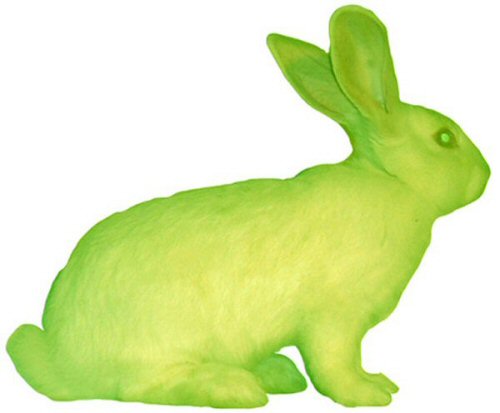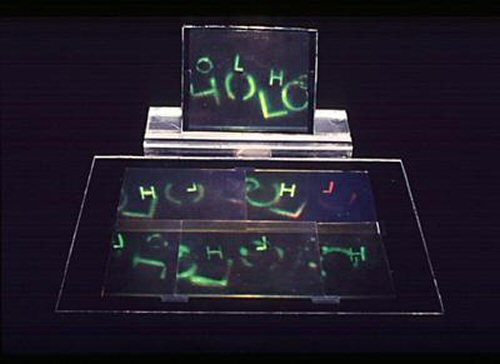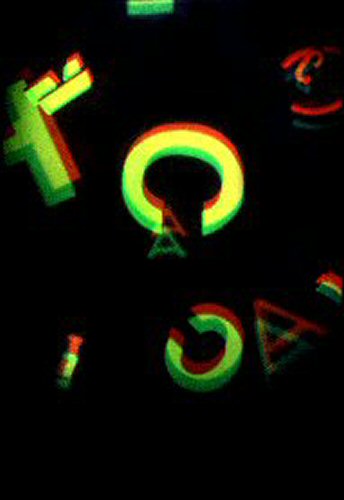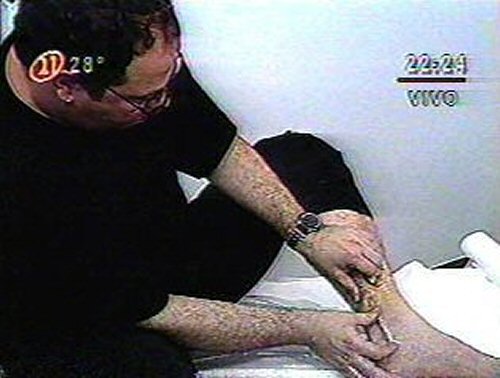Eduardo Kac
(Chicago, Illinois, United States)
In 1989, Kac headed to Chicago, Illinois (USA), to study at the School of the Art Institute of Chicago where he earned a master of fine arts degree the following year. Kac is now a Ph.D. research fellow at the Centre for Advanced Inquiry in Interactive Arts (CAiiA) at the University of Wales in Newport, Wales, and an assistant professor of art and technology at the School of the Art Institute of Chicago. He has exhibited extensively all over Europe and North and South America and received many prizes and awards, including the Leonardo Award for Excellence, ISAST in 1998 and the Inter Communication Center (Tokyo) Biennial Award in 1999.
Kac began his artistic career as a traditional performance artist but eventually moved on to investigate technology artistically through an exploration of poetry. After becoming dissatisfied with the unidimensionality of the printed word, Kac turned to holography. In 1983, he coined the term "holopoetry" (2) to describe his three-dimensional floating texts and thus began an intense relationship between artistic practice and the possibilities of technology. Works created during this time include Holo/Olho (Holo/Eye) (1983) and Chaos (1986). (3) From there, he moved on to telecommunications art and in 1986 produced his first telepresence work with remote-controlled robotics. (4)
Telecommunications art (the use of telecommunication devices such as a fax, telephone, radio or television) is an art form that according to Kac, "demonstrates the necessary move from pictorial representation to communicative experience." (5) Experience, as opposed to "the object," is substantially more unstable, open and ephemeral, but nonetheless very much linked to the material body. In that respect, for Kac, "the word 'immaterial' should be understood here as applied not to something that doesn't give itself to the senses, but as something whose ultimate reality cannot be translated into tangible materials." (6) The decision to focus on communication rather than materiality has inspired Kac to significantly reconsider traditional notions of the "viewer" and "art object" and unabashedly create his own art forms.
In 1989, Kac began working on a series of telepresence works titled Ornitorrinco (1989-1998). (7) In collaboration with hardware designer Ed Bennett, Kac created a telerobot that would respond to signals sent through various telecommunication devices. The remote audience, situated in various geographical locations throughout the life of the project, could transmit information to the robot and retrieve it from the robot's point of view. In 1994, the project evolved to include the use of the Internet. In 1996, Kac continued his exploration of telerobotics with Rara Avis (1996), a networked telepresence installation located at the Nexus Contemporary Art Center in Atlanta, Georgia, and Teleporting an Unknown State (August 4 to 9, 1996), an interactive telematic installation linking the Contemporary Art Center in New Orleans, Louisiana, to the Internet.
After thoroughly exploring the possibilities of telematics and telepresence, Kac began exploiting his interests in the new area of genetics and biotechnologies. On November 11, 1997, Kac performed Time Capsule (1997) live on Brazilian television (Canal 21). In the presence of a physician and a live television audience, Kac implanted a microchip into his left leg that allowed his body and his identity to be registered in an animal-identification database used to track lost pets. After the implant, the microchip was Web-scanned from Chicago. Within minutes of the operation, Kac was officially registered as both owner and pet. The extremely public and performative nature of this work echoes Kac's early public performances in Rio de Janeiro. This satirical fusion of flesh and technology was one of the artist's first explorations into biotechnological art. His subsequent genetic works reflect this desire to viscerally implicate the body in technology.
Kac's next collaboration with Ed Bennett in 1997 was for the work A-positive. Kac describes this work as one that :
"Probes the delicate relationship between the human body and emerging new breeds of hybrid machines that incorporate biological elements and from these elements extract sensorial or metabolic functions. The work creates a situation in which a human being and a robot have direct physical contact via an intravenous needle connected to clear tubing and feed one another in a mutually nourishing relationship. To the new category of hybrid biological robots we ascribe the general epithet 'biobots.' Because of its use of human red blood cells, the biobot created for A-positive is termed a 'phlebot.'" (8)
Introducing new terms into contemporary art criticism is something Kac has continually explored ever since his early experiments with holopoetry. His prolific career as an artist has been supplemented by his dynamic role as a critic and theorist. He has published in such journals as Leonardo, Visible Language et Art Journal. (9) In both his art and his writing, Kac has promoted three new areas of contemporary art, which he terms telepresence art, biotelematics, and transgenic art. Kac defines telepresence art as the merger of telerobotics and communications media; biotelematics as art in which a biological process is intrinsically connected to computer-based telecommunications; and transgenic art as an art form using genetic engineering to transfer either synthetic genes to an organism or natural genetic material between species so as to create unique living hybrids. (10) This last "art" form extends from the issues Kac explored with A-positive and Time Capsule.
Kac has broken new and often controversial ground with his recent project Genesis 1 and Genesis 2 in an artistic, yet very social and political context in an age when questionable genetic experiments are practised globally. In the projects GFP K-9 (1998-present) and GFP Bunny (1999-present), he has extended his transgenic explorations to mammals. In both projects, Kac has used a GFP (green fluorescent protein) commonly found in Pacific Northwest jellyfish to examine issues of genetic control and biotechnologies. Kac intends to breed a dog (GFP K-9) that will have the fluorescent protein encoded in its DNA. The dog will emit a green glow when exposed to ultraviolet or blue light. Given the advances that must be made in mapping the canine genome, this project is a work-in-progress. (11)
GFP Bunny, now more commonly known as Alba since her birth in February 2000, is a successful attempt to breed a rabbit that carries the glowing protein. Kac says he wanted to demonstrate through this installation that transgenic art doesn't involve only the creation of mutant, hybrid creatures as objects. He intends to integrate Alba into his family and promote responsibility for genetic experimentation within the artistic community. (12)
Eduardo Kac is continuing his research into the Genesis project and plans to create Genesis 2, which will focus on the protein produced by the synthetic gene spawned in Genesis 1. Kac is clearly dedicated to raising social awareness about the issues he spotlights in his art and to exploring a new artistic discourse for contemporary culture.
Angela Plohman © 2000 FDL
(1) The event took place on February 13, 1982 : http://www.ekac.org/performance.html
(2) Annick Bureaud, "Eduardo Kac, défricheur et visionnaire" Artpress No. 246 (May 1999): 35. http://www.ekac.org/artpress/kac.htm
(3) For a complete list of Kac's holopoems, see http://www.ekac.org/allholopoems.html
(4) Eduardo Kac, "Dialogical Telepresence and Net Ecology" in Ken Goldberg, ed., The Robot in the Garden: Telerobotics and Telepistomology in the Age of the Internet (Cambridge, Massachusetts: MIT Press, 2000): 183.
(5) Eduardo Kac, "Aspects of the Aesthetics of Telecommunications," Siggraph Visual Proceedings, John Grimes and Gray Lorig, eds. (New York: ACM, 1992): 48. See : http://www.ekac.org/telecom.paper.siggrap.html
(6) Eduardo Kac, "Parallels Between Telematics and Holography as Art Forms," New Observations no 76 (15 mei au 30 june 1990): 7.
(7) Ornitorrinco means ornithorynque in portugese. Experience 1 (1990); Ornitorrinco in Copacabana (1991-1992); Ornitorrinco on the Moon (1993); Ornitorrinco in Eden (1994); Ornitorrinco in the Sahara (1996); Ornitorrinco, the Webot, Travels Around the World in Eighty Nanoseconds Going from Turkey to Peru and Back (1996).
(8) See : http://www.ekac.org/apositive.html
(9) See Eduardo Kac's Web site for a complete listing of all of his publications http://www.ekac.org/vitae.html
(10) See grant proposal submitted to the Daniel Langlois Foundation by Eduardo Kac (January 31, 2000).
(11) Eduardo Kac, "Transgenic Art," Leonardo Electronic Almanac Vol. 6, no 11 (december 1998): n/p/n. See : http://www.ekac.org/transgenic.html
(12) GFP Bunny : http://www.ekac.org/gfpbunny.html
Related page:
 Eduardo Kac, Genesis 2
Eduardo Kac, Genesis 2Genesis 2 is the second phase of an earlier project by Eduardo Kac entitled Genesis 1, a transgenic installation.
External link:
http://www.ekac.org









